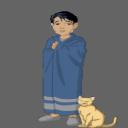Yahoo Answers is shutting down on May 4th, 2021 (Eastern Time) and beginning April 20th, 2021 (Eastern Time) the Yahoo Answers website will be in read-only mode. There will be no changes to other Yahoo properties or services, or your Yahoo account. You can find more information about the Yahoo Answers shutdown and how to download your data on this help page.
Trending News
Does the Earth have Two Moons?
Any ball shaped object in its "center of gravity" has zero gravitation because the vectors of gravitational forces compensate each other in the center. If two objects attract each other the vector of one object being directed to the other add each other the one being directed to the outside substract from each other. That can make an object spin on its orbit or prevent it from halting its spin.
The moon has a strange spin which is related to its orbit. Relatively to us it does not spin at all. That makes us see only one and the same side of the Moon. We never see its back side. Theoretically the Moon should have a spin that we see all sides by his own, independent spin. Assuming that there is no rope between Moon and Earth that behavior can only be explained by another, smaller moon which is exactly on the opposite side, stabilizing the moon's spin and constantly "hiding" relatively to ourselves on the Earth on the "backside of the Moon" (relative to the Earth). Where is my mistake?
9 Answers
- 8 years agoFavorite Answer
Actually, the moon is in 'tidal lock' with the Earth, and we see this behavior throughout the solar system - it's quite common. The Earth *kinda does* have a second moon, an asteroid that is influenced by both the Earth's motion and the sun, but it doesn't truly orbit the Earth.
The moon doesn't need to be "stabilized" in it's orbit about Earth by any other object - it's quite stable by itself.
- John WLv 78 years ago
You're over analysing orbital mechanics. The Moon's spin is due to tidal locking which is the natural stable state of an orbit, eventually everything that orbits something else will be tidally locked, the Moon just did so early on cause it's relatively small. Were the Sun to live for many billions of years longer than it will, the Earth would eventually be tidal locked to the Moon and to the Sun. You will often hear them describe an exo-planet in a habitable zone to be tidally locked, this is because not only are they in very tight orbits around their stars but their stars are often red dwarf stars which live a very long time so the planet probably had enough time to become tidally locked.
As to two Moons, there are occasional asteroids that enter complicated orbits for a few years before leaving and we almost always have one or two of those. There are asteroids in Solar orbits that place them in the vicinity of Earth. Then there are the computer models of the Moon's formation which show a second moon forming and then crashing with our Moon perhaps a hundred million years later to form our current Moon.
Your mistake is in not realizing that there already is a reason for the Moon's orbit and you don't have to create convoluted nonsense to explain it.
Source(s): http://en.wikipedia.org/wiki/Tidal_locking - ThomasLv 78 years ago
As mentioned, that the Moon always shows the same face to Earth is down to the tides. Just as the Moon raises tides on the Earth, so the Earth makes tides on the Moon; there's no oceans, but the rock still moves. This slowed the Moon's spin down until it matched its orbital period.
There could not be a second object "hiding" behind the Moon, because it wouldn't stay there. If it was just in a more distant orbit, that orbit would be slower so it would show itself within days. If it was at the L2 point, it would keep pace with the Moon to start with, but that point isn't stable so it would drift away over the course of years and show itself.
That said, Earth *did* have a second moon for a few months recently! The asteroid 2006 RH120 entered orbit around the Earth in September 2006, and went round us four times before the Sun's gravity dragged it back away in June 2007. It is much to small to have any effect on the Moon.
- Anonymous8 years ago
The moon does spin - it takes the same length of time to spin as it takes to orbit the Earth.
Its called "tidal locking" or synchronous rotation and is common to almost all the moons orbiting planets in our solar system.
If the moon DIDN'T spin at all we would see all sides of it as it orbits the Earth.
The mistake was in not researching the physics of the moon's rotation.
- How do you think about the answers? You can sign in to vote the answer.
- 8 years ago
Or, perhaps it can be explained by an uneven distribution of mass in the Moon, so that it aligns itself with Earth's gravitational field, and keep one side toward the Earth. There were many early artificial satellites that were "gravitationally stabilized" by making them have a long boom with mass at both ends (look up gravity gradient stabilization.
- 8 years ago
Yes we have 2 Moons one made of Gooda cheese the one we cant see . Not so Gooda .
Large gravitational objects that orbit close to there much more massive host become phase locked due to the tidal bulge .
Mercury the same with sun and on on and on .
- Anonymous8 years ago
Yes, but the third moon can only go swimming on Tuesdays because it is homeless.
- DrDaveLv 78 years ago
Uh, I hate to burst your bubble but we DO have images of the other side of the moon.
- RobertLv 68 years ago
Yes. They are the same size and orbit at the same speed. Their orbits are 180 degrees apart- that's why you can see them both at the same time.








